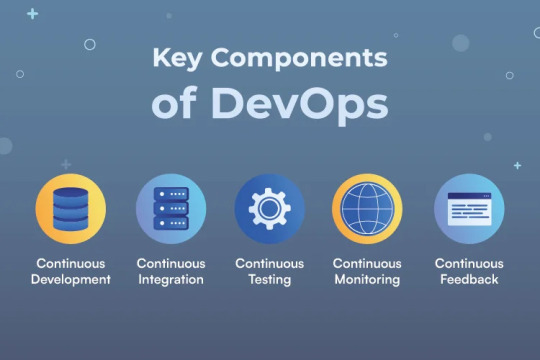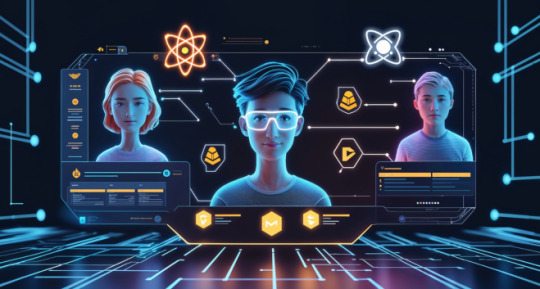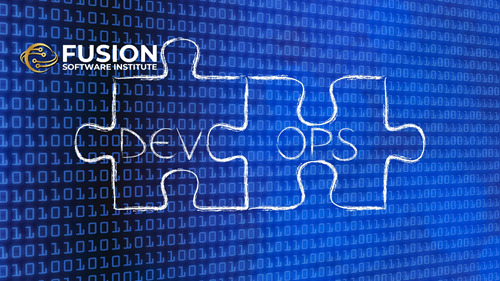#Key components of DevOps
Explore tagged Tumblr posts
Text

Devops lifecycle is a methodology used by software development developers to bring products to market faster and more efficiently.
0 notes
Text
Automated Testing vs. Manual Testing: Which One is Right for Your Project?

Achieving high-quality, reliable software stands as a fundamental requirement in software development. Successful testing functions as an essential tool to discover faults and build performance capabilities that create better user experience outcomes. Two main testing methods dominate the field: automated testing and manual testing. The process of quality software assurance uses different testing approaches that demonstrate their own advantages as well as weaknesses according to specific project requirements and scenarios. We will explore the specifics to determine which testing process works best for your system development efforts.
1. What Is Manual Testing?

Manual testing involves a human tester manually executing test cases without using automation tools. Key Characteristics:
The methodology focuses its efforts on user interface together with usability and experience testing.
Human-centered applications where selection requires discretion include ad hoc testing and enumerative testing as well as examinations that need human evaluation.
Human performers are required during this approach; thus, it demands substantial time.
2. What Is Automated Testing?

Software performing automated testing executes test cases through workflows and helpers. Key Characteristics:
Efficient for repetitive and regression testing.
Users must spend money on tools along with developing custom scripts for testing.
Reduces human error.
3. Advantages of Manual Testing

Human Intuition: Software testing professionals can detect kernels through their human cognitive ability that automated tools cannot match. The observation and evaluation of visual elements runs more efficiently through human operatives instead of advanced tools.
Flexibility: This method suits exploratory testing specifically because there are no pre-determined scripts available.
Low Initial Investment: Running this approach does not need tool purchases or applications to develop automation frameworks.
Adaptable for UI/UX Testing: Running this approach does not need tool purchases or applications to develop automation frameworks.
4. Advantages of Automated Testing

Speed: Executes repetitive tests much faster than humans.
Scalability: The system proves most effective for extensive projects that need constant system updates.
Accuracy: When performing recurring actions, automated systems minimize the chances of human mistakes.
Cost-Efficient in the Long Run: Once established and implemented, the system demands costly investments but ensures continuous development expenses decrease over time.
Better for CI/CD Pipelines: Such testing technology connects various development pipelines that support agile and DevOps methodologies.
5. Disadvantages of Manual Testing

Time-Consuming: The manual performance of repeated tests leads to delayed completion of projects.
Error-Prone: Large applications contain tiny bugs that human testers commonly fail to detect.
Not Ideal for Scalability: The process of increasing manual testing needs additional testers to avoid cost escalations.
6. Disadvantages of Automated Testing

Initial Costs: Organizations must provide high financial resources to procure testing tools together with developing programming constructs.
Limited to Pre-Defined Scenarios: These testing approaches work poorly for handling exploratory or ad hoc testing.
Requires Maintenance: Test scripts need frequent updates when application changes occur.
Not Suitable for UI/UX Testing: Struggles with subjective user experience evaluations.
7. When to Use Manual Testing

Small Projects: The testing method proves beneficial at a low cost for small applications and provides quick assessments.
Exploratory Testing: Testing this approach benefits projects whose scripts have not been defined yet or need evaluation for newly added features.
Visual and Usability Testing: Performing assessments on interface components together with design features.
8. When to Use Automated Testing

Large Projects: Handles scalability for projects with frequent updates.
Regression Testing: Program testing becomes more efficient through automation since automated assessments perform multiple tests following each update process.
Performance Testing: The system performs efficient capabilities to conduct load testing and stress testing.
Continuous Development Environments: Agile progression and DevOps implementations need automation as a core requirement.
READ MORE- https://www.precisio.tech/automated-testing-vs-manual-testing-which-one-is-right-for-your-project/
2 notes
·
View notes
Text
Exploring the Azure Technology Stack: A Solution Architect’s Journey
Kavin
As a solution architect, my career revolves around solving complex problems and designing systems that are scalable, secure, and efficient. The rise of cloud computing has transformed the way we think about technology, and Microsoft Azure has been at the forefront of this evolution. With its diverse and powerful technology stack, Azure offers endless possibilities for businesses and developers alike. My journey with Azure began with Microsoft Azure training online, which not only deepened my understanding of cloud concepts but also helped me unlock the potential of Azure’s ecosystem.
In this blog, I will share my experience working with a specific Azure technology stack that has proven to be transformative in various projects. This stack primarily focuses on serverless computing, container orchestration, DevOps integration, and globally distributed data management. Let’s dive into how these components come together to create robust solutions for modern business challenges.

Understanding the Azure Ecosystem
Azure’s ecosystem is vast, encompassing services that cater to infrastructure, application development, analytics, machine learning, and more. For this blog, I will focus on a specific stack that includes:
Azure Functions for serverless computing.
Azure Kubernetes Service (AKS) for container orchestration.
Azure DevOps for streamlined development and deployment.
Azure Cosmos DB for globally distributed, scalable data storage.
Each of these services has unique strengths, and when used together, they form a powerful foundation for building modern, cloud-native applications.
1. Azure Functions: Embracing Serverless Architecture
Serverless computing has redefined how we build and deploy applications. With Azure Functions, developers can focus on writing code without worrying about managing infrastructure. Azure Functions supports multiple programming languages and offers seamless integration with other Azure services.
Real-World Application
In one of my projects, we needed to process real-time data from IoT devices deployed across multiple locations. Azure Functions was the perfect choice for this task. By integrating Azure Functions with Azure Event Hubs, we were able to create an event-driven architecture that processed millions of events daily. The serverless nature of Azure Functions allowed us to scale dynamically based on workload, ensuring cost-efficiency and high performance.
Key Benefits:
Auto-scaling: Automatically adjusts to handle workload variations.
Cost-effective: Pay only for the resources consumed during function execution.
Integration-ready: Easily connects with services like Logic Apps, Event Grid, and API Management.
2. Azure Kubernetes Service (AKS): The Power of Containers
Containers have become the backbone of modern application development, and Azure Kubernetes Service (AKS) simplifies container orchestration. AKS provides a managed Kubernetes environment, making it easier to deploy, manage, and scale containerized applications.
Real-World Application
In a project for a healthcare client, we built a microservices architecture using AKS. Each service—such as patient records, appointment scheduling, and billing—was containerized and deployed on AKS. This approach provided several advantages:
Isolation: Each service operated independently, improving fault tolerance.
Scalability: AKS scaled specific services based on demand, optimizing resource usage.
Observability: Using Azure Monitor, we gained deep insights into application performance and quickly resolved issues.
The integration of AKS with Azure DevOps further streamlined our CI/CD pipelines, enabling rapid deployment and updates without downtime.
Key Benefits:
Managed Kubernetes: Reduces operational overhead with automated updates and patching.
Multi-region support: Enables global application deployments.
Built-in security: Integrates with Azure Active Directory and offers role-based access control (RBAC).
3. Azure DevOps: Streamlining Development Workflows
Azure DevOps is an all-in-one platform for managing development workflows, from planning to deployment. It includes tools like Azure Repos, Azure Pipelines, and Azure Artifacts, which support collaboration and automation.
Real-World Application
For an e-commerce client, we used Azure DevOps to establish an efficient CI/CD pipeline. The project involved multiple teams working on front-end, back-end, and database components. Azure DevOps provided:
Version control: Using Azure Repos for centralized code management.
Automated pipelines: Azure Pipelines for building, testing, and deploying code.
Artifact management: Storing dependencies in Azure Artifacts for seamless integration.
The result? Deployment cycles that previously took weeks were reduced to just a few hours, enabling faster time-to-market and improved customer satisfaction.
Key Benefits:
End-to-end integration: Unifies tools for seamless development and deployment.
Scalability: Supports projects of all sizes, from startups to enterprises.
Collaboration: Facilitates team communication with built-in dashboards and tracking.

4. Azure Cosmos DB: Global Data at Scale
Azure Cosmos DB is a globally distributed, multi-model database service designed for mission-critical applications. It guarantees low latency, high availability, and scalability, making it ideal for applications requiring real-time data access across multiple regions.
Real-World Application
In a project for a financial services company, we used Azure Cosmos DB to manage transaction data across multiple continents. The database’s multi-region replication ensure data consistency and availability, even during regional outages. Additionally, Cosmos DB’s support for multiple APIs (SQL, MongoDB, Cassandra, etc.) allowed us to integrate seamlessly with existing systems.
Key Benefits:
Global distribution: Data is replicated across regions with minimal latency.
Flexibility: Supports various data models, including key-value, document, and graph.
SLAs: Offers industry-leading SLAs for availability, throughput, and latency.
Building a Cohesive Solution
Combining these Azure services creates a technology stack that is flexible, scalable, and efficient. Here’s how they work together in a hypothetical solution:
Data Ingestion: IoT devices send data to Azure Event Hubs.
Processing: Azure Functions processes the data in real-time.
Storage: Processed data is stored in Azure Cosmos DB for global access.
Application Logic: Containerized microservices run on AKS, providing APIs for accessing and manipulating data.
Deployment: Azure DevOps manages the CI/CD pipeline, ensuring seamless updates to the application.
This architecture demonstrates how Azure’s technology stack can address modern business challenges while maintaining high performance and reliability.
Final Thoughts
My journey with Azure has been both rewarding and transformative. The training I received at ACTE Institute provided me with a strong foundation to explore Azure’s capabilities and apply them effectively in real-world scenarios. For those new to cloud computing, I recommend starting with a solid training program that offers hands-on experience and practical insights.
As the demand for cloud professionals continues to grow, specializing in Azure’s technology stack can open doors to exciting opportunities. If you’re based in Hyderabad or prefer online learning, consider enrolling in Microsoft Azure training in Hyderabad to kickstart your journey.
Azure’s ecosystem is continuously evolving, offering new tools and features to address emerging challenges. By staying committed to learning and experimenting, we can harness the full potential of this powerful platform and drive innovation in every project we undertake.
#cybersecurity#database#marketingstrategy#digitalmarketing#adtech#artificialintelligence#machinelearning#ai
2 notes
·
View notes
Text
Complete Terraform IAC Development: Your Essential Guide to Infrastructure as Code
If you're ready to take control of your cloud infrastructure, it's time to dive into Complete Terraform IAC Development. With Terraform, you can simplify, automate, and scale infrastructure setups like never before. Whether you’re new to Infrastructure as Code (IAC) or looking to deepen your skills, mastering Terraform will open up a world of opportunities in cloud computing and DevOps.
Why Terraform for Infrastructure as Code?
Before we get into Complete Terraform IAC Development, let’s explore why Terraform is the go-to choice. HashiCorp’s Terraform has quickly become a top tool for managing cloud infrastructure because it’s open-source, supports multiple cloud providers (AWS, Google Cloud, Azure, and more), and uses a declarative language (HCL) that’s easy to learn.
Key Benefits of Learning Terraform
In today's fast-paced tech landscape, there’s a high demand for professionals who understand IAC and can deploy efficient, scalable cloud environments. Here’s how Terraform can benefit you and why the Complete Terraform IAC Development approach is invaluable:
Cross-Platform Compatibility: Terraform supports multiple cloud providers, which means you can use the same configuration files across different clouds.
Scalability and Efficiency: By using IAC, you automate infrastructure, reducing errors, saving time, and allowing for scalability.
Modular and Reusable Code: With Terraform, you can build modular templates, reusing code blocks for various projects or environments.
These features make Terraform an attractive skill for anyone working in DevOps, cloud engineering, or software development.
Getting Started with Complete Terraform IAC Development
The beauty of Complete Terraform IAC Development is that it caters to both beginners and intermediate users. Here’s a roadmap to kickstart your learning:
Set Up the Environment: Install Terraform and configure it for your cloud provider. This step is simple and provides a solid foundation.
Understand HCL (HashiCorp Configuration Language): Terraform’s configuration language is straightforward but powerful. Knowing the syntax is essential for writing effective scripts.
Define Infrastructure as Code: Begin by defining your infrastructure in simple blocks. You’ll learn to declare resources, manage providers, and understand how to structure your files.
Use Modules: Modules are pre-written configurations you can use to create reusable code blocks, making it easier to manage and scale complex infrastructures.
Apply Best Practices: Understanding how to structure your code for readability, reliability, and reusability will save you headaches as projects grow.
Core Components in Complete Terraform IAC Development
When working with Terraform, you’ll interact with several core components. Here’s a breakdown:
Providers: These are plugins that allow Terraform to manage infrastructure on your chosen cloud platform (AWS, Azure, etc.).
Resources: The building blocks of your infrastructure, resources represent things like instances, databases, and storage.
Variables and Outputs: Variables let you define dynamic values, and outputs allow you to retrieve data after deployment.
State Files: Terraform uses a state file to store information about your infrastructure. This file is essential for tracking changes and ensuring Terraform manages the infrastructure accurately.
Mastering these components will solidify your Terraform foundation, giving you the confidence to build and scale projects efficiently.
Best Practices for Complete Terraform IAC Development
In the world of Infrastructure as Code, following best practices is essential. Here are some tips to keep in mind:
Organize Code with Modules: Organizing code with modules promotes reusability and makes complex structures easier to manage.
Use a Remote Backend: Storing your Terraform state in a remote backend, like Amazon S3 or Azure Storage, ensures that your team can access the latest state.
Implement Version Control: Version control systems like Git are vital. They help you track changes, avoid conflicts, and ensure smooth rollbacks.
Plan Before Applying: Terraform’s “plan” command helps you preview changes before deploying, reducing the chances of accidental alterations.
By following these practices, you’re ensuring your IAC deployments are both robust and scalable.
Real-World Applications of Terraform IAC
Imagine you’re managing a complex multi-cloud environment. Using Complete Terraform IAC Development, you could easily deploy similar infrastructures across AWS, Azure, and Google Cloud, all with a few lines of code.
Use Case 1: Multi-Region Deployments
Suppose you need a web application deployed across multiple regions. Using Terraform, you can create templates that deploy the application consistently across different regions, ensuring high availability and redundancy.
Use Case 2: Scaling Web Applications
Let’s say your company’s website traffic spikes during a promotion. Terraform allows you to define scaling policies that automatically adjust server capacities, ensuring that your site remains responsive.
Advanced Topics in Complete Terraform IAC Development
Once you’re comfortable with the basics, Complete Terraform IAC Development offers advanced techniques to enhance your skillset:
Terraform Workspaces: Workspaces allow you to manage multiple environments (e.g., development, testing, production) within a single configuration.
Dynamic Blocks and Conditionals: Use dynamic blocks and conditionals to make your code more adaptable, allowing you to define configurations that change based on the environment or input variables.
Integration with CI/CD Pipelines: Integrate Terraform with CI/CD tools like Jenkins or GitLab CI to automate deployments. This approach ensures consistent infrastructure management as your application evolves.
Tools and Resources to Support Your Terraform Journey
Here are some popular tools to streamline your learning:
Terraform CLI: The primary tool for creating and managing your infrastructure.
Terragrunt: An additional layer for working with Terraform, Terragrunt simplifies managing complex Terraform environments.
HashiCorp Cloud: Terraform Cloud offers a managed solution for executing and collaborating on Terraform workflows.
There are countless resources available online, from Terraform documentation to forums, blogs, and courses. HashiCorp offers a free resource hub, and platforms like Udemy provide comprehensive courses to guide you through Complete Terraform IAC Development.
Start Your Journey with Complete Terraform IAC Development
If you’re aiming to build a career in cloud infrastructure or simply want to enhance your DevOps toolkit, Complete Terraform IAC Development is a skill worth mastering. From managing complex multi-cloud infrastructures to automating repetitive tasks, Terraform provides a powerful framework to achieve your goals.
Start with the basics, gradually explore advanced features, and remember: practice is key. The world of cloud computing is evolving rapidly, and those who know how to leverage Infrastructure as Code will always have an edge. With Terraform, you’re not just coding infrastructure; you’re building a foundation for the future. So, take the first step into Complete Terraform IAC Development—it’s your path to becoming a versatile, skilled cloud professional
2 notes
·
View notes
Text
Azure DevOps Training
Azure DevOps Training Programs

In today's rapidly evolving tech landscape, mastering Azure DevOps has become indispensable for organizations aiming to streamline their software development and delivery processes. As businesses increasingly migrate their operations to the cloud, the demand for skilled professionals proficient in Azure DevOps continues to soar. In this comprehensive guide, we'll delve into the significance of Azure DevOps training and explore the myriad benefits it offers to both individuals and enterprises.
Understanding Azure DevOps:
Before we delve into the realm of Azure DevOps training, let's first grasp the essence of Azure DevOps itself. Azure DevOps is a robust suite of tools offered by Microsoft Azure that facilitates collaboration, automation, and orchestration across the entire software development lifecycle. From planning and coding to building, testing, and deployment, Azure DevOps provides a unified platform for managing and executing diverse DevOps tasks seamlessly.
Why Azure DevOps Training Matters:
With Azure DevOps emerging as the cornerstone of modern DevOps practices, acquiring proficiency in this domain has become imperative for IT professionals seeking to stay ahead of the curve. Azure DevOps training equips individuals with the knowledge and skills necessary to leverage Microsoft Azure's suite of tools effectively. Whether you're a developer, IT administrator, or project manager, undergoing Azure DevOps training can significantly enhance your career prospects and empower you to drive innovation within your organization.
Key Components of Azure DevOps Training Programs:
Azure DevOps training programs are meticulously designed to cover a wide array of topics essential for mastering the intricacies of Azure DevOps. From basic concepts to advanced techniques, these programs encompass the following key components:
Azure DevOps Fundamentals: An in-depth introduction to Azure DevOps, including its core features, functionalities, and architecture.
Agile Methodologies: Understanding Agile principles and practices, and how they align with Azure DevOps for efficient project management and delivery.
Continuous Integration (CI): Learning to automate the process of integrating code changes into a shared repository, thereby enabling early detection of defects and ensuring software quality.
Continuous Deployment (CD): Exploring the principles of continuous deployment and mastering techniques for automating the deployment of applications to production environments.
Azure Pipelines: Harnessing the power of Azure Pipelines for building, testing, and deploying code across diverse platforms and environments.
Infrastructure as Code (IaC): Leveraging Infrastructure as Code principles to automate the provisioning and management of cloud resources using tools like Azure Resource Manager (ARM) templates.
Monitoring and Logging: Implementing robust monitoring and logging solutions to gain insights into application performance and troubleshoot issues effectively.
Security and Compliance: Understanding best practices for ensuring the security and compliance of Azure DevOps environments, including identity and access management, data protection, and regulatory compliance.
The Benefits of Azure DevOps Certification:
Obtaining Azure DevOps certification not only validates your expertise in Azure DevOps but also serves as a testament to your commitment to continuous learning and professional development. Azure DevOps certifications offered by Microsoft Azure are recognized globally and can open doors to exciting career opportunities in various domains, including cloud computing, software development, and DevOps engineering.
Conclusion:
In conclusion, Azure DevOps training is indispensable for IT professionals looking to enhance their skills and stay relevant in today's dynamic tech landscape. By undergoing comprehensive Azure DevOps training programs and obtaining relevant certifications, individuals can unlock a world of opportunities and propel their careers to new heights. Whether you're aiming to streamline your organization's software delivery processes or embark on a rewarding career journey, mastering Azure DevOps is undoubtedly a game-changer. So why wait? Start your Azure DevOps training journey today and pave the way for a brighter tomorrow.
5 notes
·
View notes
Text
Why DevOps Training Matters: A Deep Dive into the Benefits
In the ever-evolving landscape of software development and IT operations, DevOps has emerged as a transformative approach that promises to revolutionize the way organizations build, deploy, and manage software. However, embracing DevOps is not just about adopting a set of tools and practices; it's about fostering a culture of collaboration, automation, and continuous improvement. DevOps training is the linchpin that empowers professionals and organizations to unlock the full potential of this methodology.

In this comprehensive guide, we will delve into the myriad benefits of DevOps training, explore why it is crucial in today's tech-driven world, and highlight the role of ACTE Technologies in providing top-tier DevOps training programs.
Why is DevOps Training Crucial?
Before we dive into the specific advantages of DevOps training, it's essential to understand why training in this field is so pivotal:
1. A Paradigm Shift: DevOps represents a paradigm shift in software development and IT operations. It demands a new way of thinking, collaborating, and working. DevOps training equips professionals with the knowledge and skills needed to navigate this transformation successfully.
2. Evolving Skill Set: DevOps requires a diverse skill set that spans development, operations, automation, and collaboration. Training ensures that individuals are well-rounded in these areas, making them valuable assets to their organizations.
3. Continuous Learning: DevOps is not a one-time implementation; it's an ongoing journey of continuous improvement. DevOps training instills a mindset of continual learning and adaptation, ensuring that professionals stay relevant in a rapidly changing tech landscape.
The Key Benefits of DevOps Training:
Now that we've established the importance of DevOps training, let's explore its key benefits:
1. Improved Collaboration:
The main goal of DevOps is to eliminate silos between the development and operations teams. It fosters collaboration and communication throughout the software development lifecycle. DevOps training teaches professionals how to facilitate seamless interaction between these traditionally separate groups, resulting in faster issue resolution and enhanced efficiency.
2. Continuous Integration and Deployment (CI/CD):
One of the cornerstones of DevOps is the implementation of CI/CD pipelines. These pipelines automate code integration, testing, and deployment processes. DevOps training equips practitioners with the skills to design and manage CI/CD pipelines, leading to quicker releases, reduced errors, and improved software quality.
3. Automation Skills:
Automation is a fundamental aspect of DevOps. It streamlines repetitive tasks, reduces manual errors, and accelerates processes. DevOps training provides hands-on experience with automation tools and practices, enabling professionals to automate tasks such as infrastructure provisioning, configuration management, and testing.
4. Enhanced Problem-Solving:
DevOps encourages proactive problem-solving. Through real-time monitoring and alerting, professionals can identify and resolve issues swiftly, minimizing downtime and ensuring a seamless user experience. DevOps training imparts essential monitoring and troubleshooting skills.
5. Scalability:
As organizations grow, their software and infrastructure must scale to accommodate increased demand. DevOps training teaches professionals how to design and implement scalable solutions that can adapt to changing workloads and requirements.
6. Security:
Security is an integral part of DevOps, with "DevSecOps" practices being widely adopted. DevOps training emphasizes the importance of security measures throughout the development process, ensuring that security is not an afterthought but an integral component of every stage.
7. Cost Efficiency:
By automating processes and optimizing resource utilization, DevOps can lead to significant cost savings. DevOps training helps professionals identify cost-saving opportunities within their organizations, making them valuable assets in cost-conscious environments.
8. Career Advancement:
Professionals with DevOps skills are in high demand. DevOps training can open doors to better job opportunities, career growth, and higher salaries. It's a strategic investment in your career advancement.

In a tech landscape where agility, efficiency, and collaboration are paramount, DevOps training is the key to unlocking your potential as a DevOps professional. The benefits are undeniable, ranging from improved collaboration and problem-solving to career advancement and cost efficiency.
If you're considering pursuing DevOps training, ACTE Technologies can be your trusted partner on this transformative journey. Their expert guidance, comprehensive courses, and hands-on learning experiences will not only help you pass certification exams but also excel in your DevOps career.
Don't miss out on the opportunity to master this transformative methodology. Start your DevOps training journey today with ACTE Technologies and pave the way for a successful and fulfilling career in the world of DevOps!
9 notes
·
View notes
Text
From Novice to Pro: Master the Cloud with AWS Training!
In today's rapidly evolving technology landscape, cloud computing has emerged as a game-changer, providing businesses with unparalleled flexibility, scalability, and cost-efficiency. Among the various cloud platforms available, Amazon Web Services (AWS) stands out as a leader, offering a comprehensive suite of services and solutions. Whether you are a fresh graduate eager to kickstart your career or a seasoned professional looking to upskill, AWS training can be the gateway to success in the cloud. This article explores the key components of AWS training, the reasons why it is a compelling choice, the promising placement opportunities it brings, and the numerous benefits it offers.

Key Components of AWS Training
1. Foundational Knowledge: Building a Strong Base
AWS training starts by laying a solid foundation of cloud computing concepts and AWS-specific terminology. It covers essential topics such as virtualization, storage types, networking, and security fundamentals. This groundwork ensures that even individuals with little to no prior knowledge of cloud computing can grasp the intricacies of AWS technology easily.
2. Core Services: Exploring the AWS Portfolio
Once the fundamentals are in place, AWS training delves into the vast array of core services offered by the platform. Participants learn about compute services like Amazon Elastic Compute Cloud (EC2), storage options such as Amazon Simple Storage Service (S3), and database solutions like Amazon Relational Database Service (RDS). Additionally, they gain insights into services that enhance performance, scalability, and security, such as Amazon Virtual Private Cloud (VPC), AWS Identity and Access Management (IAM), and AWS CloudTrail.
3. Specialized Domains: Nurturing Expertise
As participants progress through the training, they have the opportunity to explore advanced and specialized areas within AWS. These can include topics like machine learning, big data analytics, Internet of Things (IoT), serverless computing, and DevOps practices. By delving into these niches, individuals can gain expertise in specific domains and position themselves as sought-after professionals in the industry.

Reasons to Choose AWS Training
1. Industry Dominance: Aligning with the Market Leader
One of the significant reasons to choose AWS training is the platform's unrivaled market dominance. With a staggering market share, AWS is trusted and adopted by businesses across industries worldwide. By acquiring AWS skills, individuals become part of the ecosystem that powers the digital transformation of numerous organizations, enhancing their career prospects significantly.
2. Comprehensive Learning Resources: Abundance of Educational Tools
AWS training offers a wealth of comprehensive learning resources, ranging from extensive documentation, tutorials, and whitepapers to hands-on labs and interactive courses. These resources cater to different learning preferences, enabling individuals to choose their preferred mode of learning and acquire a deep understanding of AWS services and concepts.
3. Recognized Certifications: Validating Expertise
AWS certifications are globally recognized credentials that validate an individual's competence in using AWS services and solutions effectively. By completing AWS training and obtaining certifications like AWS Certified Solutions Architect or AWS Certified Developer, individuals can boost their professional credibility, open doors to new job opportunities, and command higher salaries in the job market.
Placement Opportunities
Upon completing AWS training, individuals can explore a multitude of placement opportunities. The demand for professionals skilled in AWS is soaring, as organizations increasingly migrate their infrastructure to the cloud or adopt hybrid cloud strategies. From startups to multinational corporations, industries spanning finance, healthcare, retail, and more seek talented individuals who can architect, develop, and manage cloud-based solutions using AWS. This robust demand translates into a plethora of rewarding career options and a higher likelihood of finding positions that align with one's interests and aspirations.

In conclusion, mastering the cloud with AWS training at ACTE institute provides individuals with a solid foundation, comprehensive knowledge, and specialized expertise in one of the most dominant cloud platforms available. The reasons to choose AWS training are compelling, ranging from the industry's unparalleled market position to the top ranking state.
9 notes
·
View notes
Text
#DevOps lifecycle#components of devops lifecycle#different phases in devops lifecycle#best devops consulting in toronto#best devops consulting in canada#DevOps#kubernetes#docker#agile
2 notes
·
View notes
Text
Explore Career Opportunities: The Importance of Selenium WebDriver Training"
In the rapidly evolving landscape of software testing, proficiency in Selenium WebDriver has become a key differentiator for professionals. Whether you're already in the field or aspiring to enter it, investing time in Selenium WebDriver training can significantly boost your career prospects. Embracing Selenium's capabilities becomes even more accessible and impactful with Selenium Training in Hyderabad. This training equips individuals with the skills and knowledge to harness the full potential of Selenium, enabling them to proficiently navigate web automation challenges and contribute effectively to their respective fields. Let's delve into the reasons why acquiring skills in Selenium WebDriver is essential for a successful career in software testing.

1. Industry Relevance:
Selenium WebDriver is not just another tool; it's an industry-standard for automating web applications. Its widespread adoption across various sectors makes it a must-have skill for professionals in the field of software testing and quality assurance. Knowing Selenium WebDriver is a clear indicator of industry relevance.
2. Career Opportunities:
The demand for professionals with Selenium skills is on the rise. Many organizations specifically seek candidates well-versed in Selenium when hiring for testing roles. Whether you're aiming for a test automation engineer position or a quality assurance role, Selenium proficiency enhances your employability.
3. Efficient Testing Practices:
One of the primary benefits of Selenium WebDriver is its ability to automate repetitive testing tasks. This not only accelerates the testing process but also ensures more reliable results. Automated testing with Selenium can significantly reduce the time and effort required for regression testing, enabling faster and more efficient releases.
4. Cross-Browser Testing:
Web applications need to provide a consistent user experience across various browsers. Selenium WebDriver supports cross-browser testing, allowing you to test your applications on different browsers like Chrome, Firefox, Safari, and more. This capability is crucial for identifying and addressing compatibility issues.
5. Integration with Other Tools:
Selenium WebDriver seamlessly integrates with other tools and frameworks, such as TestNG and JUnit. This integration enhances the overall test automation capabilities, making it easier to manage and report test results. A well-integrated testing environment is a valuable asset for any QA professional. To unlock the full potential of Selenium and master the art of web automation, consider enrolling in the Top Selenium Training Institute.
6. Continuous Integration and Continuous Deployment (CI/CD):
In the era of DevOps, where continuous integration and continuous deployment are standard practices, Selenium WebDriver plays a pivotal role. Automated testing is a critical component of CI/CD pipelines, ensuring that new code changes don't introduce regressions. Knowledge of Selenium is, therefore, advantageous in a DevOps environment.

7. Cost-Efficiency:
Automated testing with Selenium proves to be cost-efficient, particularly for large and complex applications. While setting up automated scripts requires an initial investment of time and resources, the long-term benefits in terms of reduced manual testing efforts and faster release cycles outweigh the initial costs.
8. Skill Diversification:
Adding Selenium WebDriver to your skill set goes beyond just mastering a tool; it's about diversifying your expertise. For professionals in software development or quality assurance, knowing Selenium showcases your commitment to staying abreast of industry-relevant tools and technologies.
In conclusion, Selenium WebDriver training is not just about learning a tool; it's about unlocking a world of career opportunities. As the demand for skilled software testing professionals continues to grow, those with Selenium proficiency will find themselves well-positioned for success. Whether you're aiming to advance in your current role or explore new career horizons, investing in Selenium WebDriver training is a strategic move that can propel your career to new heights.
2 notes
·
View notes
Text
Enterprise Kubernetes Storage with Red Hat OpenShift Data Foundation (DO370)
In the era of cloud-native transformation, data is the fuel powering everything from mission-critical enterprise apps to real-time analytics platforms. However, as Kubernetes adoption grows, many organizations face a new set of challenges: how to manage persistent storage efficiently, reliably, and securely across distributed environments.
To solve this, Red Hat OpenShift Data Foundation (ODF) emerges as a powerful solution — and the DO370 training course is designed to equip professionals with the skills to deploy and manage this enterprise-grade storage platform.
🔍 What is Red Hat OpenShift Data Foundation?
OpenShift Data Foundation is an integrated, software-defined storage solution that delivers scalable, resilient, and cloud-native storage for Kubernetes workloads. Built on Ceph and Rook, ODF supports block, file, and object storage within OpenShift, making it an ideal choice for stateful applications like databases, CI/CD systems, AI/ML pipelines, and analytics engines.
🎯 Why Learn DO370?
The DO370: Red Hat OpenShift Data Foundation course is specifically designed for storage administrators, infrastructure architects, and OpenShift professionals who want to:
✅ Deploy ODF on OpenShift clusters using best practices.
✅ Understand the architecture and internal components of Ceph-based storage.
✅ Manage persistent volumes (PVs), storage classes, and dynamic provisioning.
✅ Monitor, scale, and secure Kubernetes storage environments.
✅ Troubleshoot common storage-related issues in production.
🛠️ Key Features of ODF for Enterprise Workloads
1. Unified Storage (Block, File, Object)
Eliminate silos with a single platform that supports diverse workloads.
2. High Availability & Resilience
ODF is designed for fault tolerance and self-healing, ensuring business continuity.
3. Integrated with OpenShift
Full integration with the OpenShift Console, Operators, and CLI for seamless Day 1 and Day 2 operations.
4. Dynamic Provisioning
Simplifies persistent storage allocation, reducing manual intervention.
5. Multi-Cloud & Hybrid Cloud Ready
Store and manage data across on-prem, public cloud, and edge environments.
📘 What You Will Learn in DO370
Installing and configuring ODF in an OpenShift environment.
Creating and managing storage resources using the OpenShift Console and CLI.
Implementing security and encryption for data at rest.
Monitoring ODF health with Prometheus and Grafana.
Scaling the storage cluster to meet growing demands.
🧠 Real-World Use Cases
Databases: PostgreSQL, MySQL, MongoDB with persistent volumes.
CI/CD: Jenkins with persistent pipelines and storage for artifacts.
AI/ML: Store and manage large datasets for training models.
Kafka & Logging: High-throughput storage for real-time data ingestion.
👨🏫 Who Should Enroll?
This course is ideal for:
Storage Administrators
Kubernetes Engineers
DevOps & SRE teams
Enterprise Architects
OpenShift Administrators aiming to become RHCA in Infrastructure or OpenShift
🚀 Takeaway
If you’re serious about building resilient, performant, and scalable storage for your Kubernetes applications, DO370 is the must-have training. With ODF becoming a core component of modern OpenShift deployments, understanding it deeply positions you as a valuable asset in any hybrid cloud team.
🧭 Ready to transform your Kubernetes storage strategy? Enroll in DO370 and master Red Hat OpenShift Data Foundation today with HawkStack Technologies – your trusted Red Hat Certified Training Partner. For more details www.hawkstack.com
0 notes
Text
Next-Gen Security Testing Services Using AI: A Deep Dive

In the ever-evolving landscape of software development, security breaches have grown more frequent and sophisticated. Traditional testing methods, though foundational, are no longer sufficient in identifying and addressing the fast-moving threats facing modern systems. This is where Next-Gen Security Testing Services come into play, blending AI innovation with robust testing protocols.
At Robotico Digital, we’ve redefined how security integrates into software engineering by embedding Artificial Intelligence (AI) into our advanced Security Testing Services. This deep dive explores how AI transforms Security Testing in Software Testing, enabling faster detection, smarter remediation, and continuous protection across development pipelines.
The Shift Toward AI in Security Testing
Historically, Security Testing Services were heavily reliant on manual reviews, rule-based scanners, and time-intensive penetration testing. While still valuable, these methods struggle to keep up with:
lRapid DevOps cycles
lEvolving attack vectors
lIncreasing application complexity
lHybrid cloud and microservices infrastructure
AI, specifically through machine learning (ML), Natural Language Processing (NLP), and behavioral analytics, has introduced a transformative layer of intelligence to these services. It allows security testers and developers to go beyond reactive defenses—identifying risks proactively and at scale.
How AI Enhances Security Testing in Software Testing
Incorporating AI into Security Testing in Software Testing provides multi-dimensional improvements across efficiency, accuracy, and adaptability. Let’s break down the core components.
1. Automated Vulnerability Detection
AI-powered scanners can crawl source code, binary files, API endpoints, and web interfaces to detect anomalies that indicate vulnerabilities. Unlike traditional scanners, AI engines learn from past vulnerabilities and global threat databases to continually improve detection precision.
Key Features:
lPattern recognition across massive codebases
lZero-day threat detection using anomaly detection models
lAuto-mapping of application attack surfaces
2. Adaptive Risk Prioritization
One major challenge in Security Testing Services is managing false positives and prioritizing true threats. AI models rank vulnerabilities based on:
lExploitability
lBusiness impact
lData sensitivity
lThreat intelligence feeds
This reduces alert fatigue and ensures engineering teams focus on high-priority issues first.
3. Dynamic Threat Modeling
AI systems can automatically generate and update threat models for evolving software architectures. By simulating attacker behavior, AI enables predictive testing—discovering how vulnerabilities might be chained or escalated.
4. Self-Learning Penetration Testing
AI agents mimic ethical hackers using reinforcement learning. These bots evolve through trial and error, discovering unconventional paths to exploitation and mimicking real-world attack tactics.
Robotico Digital’s AI-Powered Security Testing Stack
At Robotico Digital, we’ve built a proprietary AI-enhanced testing framework designed to deliver intelligent, continuous, and scalable security coverage. Here's what powers our next-gen Security Testing Services:
AI-Powered SAST & DAST Engines
SAST (Static Application Security Testing): Our AI models review code for insecure functions, misconfigurations, and data flow leaks at the source level.
DAST (Dynamic Application Security Testing): AI crawlers test running applications by simulating user behavior and injecting payloads to trigger security vulnerabilities.
Machine-Learning Vulnerability Correlation
We reduce redundant findings by merging results from multiple tools and identifying duplicate alerts. ML models group similar issues, track them across builds, and learn from developer remediation behavior.
AI-Based Compliance Validation
Robotico Digital uses AI to ensure compliance with:
lOWASP Top 10
lGDPR / HIPAA / PCI DSS
lNIST and ISO 27001 We map discovered vulnerabilities to these frameworks, highlighting gaps in your security and compliance posture.
Use Cases of AI in Security Testing Services
Web & Mobile Application Testing
AI identifies issues such as insecure authentication, broken access controls, and injection attacks. It tests logic errors and parameter tampering based on how real users interact with the app.
API Security Testing
APIs are high-value targets. Our AI models analyze OpenAPI/Swagger specs, apply fuzzing techniques, and test for broken object-level authorization (BOLA) and mass assignment vulnerabilities.
Cloud & Infrastructure Testing
For cloud-native applications, AI detects misconfigurations in IAM roles, storage permissions, and network security groups—especially in multi-cloud environments like AWS, Azure, and GCP.
DevSecOps Pipeline Integration
Robotico Digital integrates AI-based scanning tools directly into CI/CD platforms like GitLab, Jenkins, and Azure DevOps. This ensures shift-left security with automated gates at every build stage.
Implementation Challenges & Considerations
While the benefits are substantial, integrating AI into Security Testing Services is not without hurdles:
1. Data Quality & Training Bias
AI models require high-quality, labeled data to function accurately. Poor or biased training datasets can lead to both false positives and false negatives.
2. Explainability & Developer Trust
“Black-box” decisions from AI can frustrate developers. Robotico Digital addresses this by using explainable AI (XAI) models that provide root cause analysis and remediation context.
3. AI Model Drift
Security threats evolve. AI models must be updated regularly to avoid “drift” that could miss emerging threats. We maintain continuous model updates with feedback loops from threat intelligence systems.
Future of AI in Security Testing Services
AI in Security Testing Services is still in its growth phase. Here’s what’s on the horizon:
lGenerative AI for Test Case Creation: Using models like GPT-4 to simulate attacks and generate intelligent test scripts.
lAutonomous Remediation Agents: AI that not only finds issues but can propose or apply secure code fixes autonomously.
lFederated Threat Learning: Secure sharing of anonymized threat data across organizations to train more resilient models.
lAI-Powered Red Teaming: Simulated human-like attackers that learn and evolve to breach complex systems.
Conclusion
Security is not a checkbox; it’s a continuous journey. As applications grow more complex and the cyber threat landscape expands, relying on traditional methods alone is no longer enough. AI enables Security Testing Services to become proactive, intelligent, and deeply integrated into the development lifecycle.
At Robotico Digital, we’re proud to lead the next generation of Security Testing in Software Testing by harnessing the power of artificial intelligence. Our AI-enhanced services empower organizations to detect vulnerabilities faster, respond more intelligently, and scale their cybersecurity operations with confidence.
0 notes
Text
Self-Healing Test Automation: The Future of Reliable Testing with ideyaLabs

Revolutionize Your Quality Assurance with Self-Healing Test Automation Self-Healing Test Automation stands at the forefront of the software development lifecycle. ideyaLabs brings this transformative approach to organizations that demand efficiency, agility, and reliability. Automated tests often falter when changes occur in the codebase. This evolution often slows down deployment and increases maintenance workloads. Self-Healing Test Automation resolves these challenges.
What is Self-Healing Test Automation? Self-Healing Test Automation uses advanced algorithms to detect and fix test script failures automatically. The system identifies changes in the user interface or back-end structure. Whenever tests fail due to altered elements, the self-healing engine analyzes patterns, locates the new elements, and updates the scripts in real time. Testing teams monitor and validate without manual interference.
How ideyaLabs Implements Self-Healing Test Automation ideyaLabs tailors self-healing solutions to address unique business needs. Automation frameworks integrate seamlessly with existing tools. Machine learning components track the behavior of test scripts. Automated systems ensure that test cases dynamically adjust when updates in application interfaces occur. Teams enjoy uninterrupted test execution cycles. Projects stay on schedule and defects come under control.
Benefits of Self-Healing Test Automation with ideyaLabs Organizations achieve significant time savings. Maintenance costs drop as test scripts self-correct without human intervention. Automation frameworks remain robust, even during rapid software releases. Teams focus on valuable exploratory testing. Reliable tests accelerate go-to-market strategies. ideyaLabs clients boost product quality and operational velocity.
Eliminate Manual Test Maintenance Manual intervention often derails productivity. Self-Healing Test Automation eradicates mundane and repetitive test maintenance tasks. ideyaLabs empowers teams to shift attention toward innovative work. Engineers concentrate on developing new features, while the self-healing engine manages test scripts.
Continuous Integration with Zero Downtime Seamless integration with CI/CD pipelines marks a key strength of Self-Healing Test Automation. ideyaLabs optimizes pipelines by automating script updates during every build and deployment. Software updates no longer break automated tests. Teams receive instant feedback on application stability.
Machine Learning Enhances Self-Healing Accuracy Machine learning principles drive the efficiency of self-healing test scripts. ideyaLabs equips frameworks with smart algorithms. Systems recognize element locators, assess historical changes, and intelligently predict likely replacements. This elevated accuracy delivers resilience in the face of UI or code updates.
Accelerate Digital Transformation Businesses shift to digital-first approaches. Rapid updates remain vital in today’s marketplaces. Self-Healing Test Automation allows organizations to innovate faster. ideyaLabs ensures software releases meet the highest quality standards, supporting agile and DevOps methodologies.
Reduced Risk in Production Releases Poorly maintained test scripts result in hidden bugs and failed deployments. Self-Healing Test Automation eliminates such risks. ideyaLabs delivers proactive identification and correction of test script issues. Releases progress smoothly. Operational confidence increases across engineering teams.
Scalability for Enterprise Applications Large enterprise applications feature complex UIs and frequent changes. ideyaLabs deploys scalable self-healing automation frameworks to handle vast test suites. Test maintenance remains minimal, regardless of application size or complexity. QA departments experience less friction during expansion.
Elevate Collaboration Across Teams Test automation becomes more approachable and efficient with self-healing capabilities. ideyaLabs fosters cross-functional collaboration between testers, developers, and business users. Teams access real-time dashboards with test outcomes. Responsibility for quality becomes a shared objective.
Security and Compliance Prioritized Automated adaptation of test scripts preserves test coverage for critical functionalities. ideyaLabs frameworks comply with rigorous security and industry standards. Sensitive data remains protected during testing cycles. Compliance audits receive comprehensive evidence.
Faster Feedback Loops Drive Continuous Improvement Feedback speed drives rapid improvement. ideyaLabs speeds up reporting cycles with real-time detection and healing of test failures. Developers receive faster insights. Corrections occur sooner in the development stream.
Enhanced ROI from QA Investments Investment in QA yields greater returns with self-healing technology. ideyaLabs clients notice measurable improvements in delivery speed, reliability, and cost savings. Automated processes reduce overhead for maintenance. Business leaders realize faster payback periods.
Self-Healing Test Automation: A Must for Modern Organizations Organizations demand predictable outputs and high software quality. Self-Healing Test Automation addresses these needs. ideyaLabs provides cutting-edge services and solutions tailored to modern development challenges.
How to Start with ideyaLabs Self-Healing Test Automation Initiating a project requires collaborative assessment and planning. ideyaLabs experts consult with stakeholders to understand project requirements. Teams receive walkthroughs on integration with current frameworks. The implementation phase unfolds with minimal disruption. Support covers every step.
Case Studies Highlight Success Stories ideyaLabs has spearheaded automation success for clients in finance, healthcare, retail, and technology. Self-healing frameworks reduced test maintenance by up to 85% in diverse projects. Clients report on improved system reliability and faster deployment cycles.
Preparing for the Future of Testing Trends continue to shift. ideyaLabs positions clients at the forefront of innovation. Self-Healing Test Automation stands as the bedrock for future-ready QA processes. Automation adapts, learns, and evolves with each release.
Partner with ideyaLabs for Test Automation Excellence Choose ideyaLabs for seamless, sustainable, and scalable test automation. Experience superior quality assurance with minimal maintenance effort. Contact ideyaLabs today to transform your testing approach with Self-Healing Test Automation.
0 notes
Text
AI/ML and Low Code App Development Company in India
Businesses in the modern high-velocity digital environment require smart, flexible, and economical solutions to outpace the competition. CodeReady Software integrates the AI/ML with the process of developing high-performance apps in less time, and with higher speed.
As a leading AI/ML and low code app development company in India, we help startups, SMEs, and enterprises automate processes, enhance customer experiences, and scale rapidly—with minimal coding and maximum intelligence.

Why Choose CodeReady Software?
At CodeReady Software, we specialize in helping businesses accelerate digital transformation using low-code platforms and AI/ML-powered mobile applications. As a trusted low code app development company in India, we reduce development time, enhance efficiency, and deliver innovative, future-ready mobile and web apps.
As a top AI/ML mobile app development company in India, we integrate predictive analytics, machine learning models, and intelligent automation into mobile applications to solve real-world problems and improve user experiences.
Key Benefits:
Drag-and-drop interface and visual development tools
Advanced AI integrations like chatbots, recommendation systems, and automation
Cross-platform app deployment with minimal code
Rapid time-to-market with cost-effective development
Our Core Services
Low-Code App Development Harness the power of low-code platforms to create business apps in days, not months. From MVPs to enterprise solutions, we offer flexible, scalable, and customized development for all industries.
AI/ML Mobile App Development Bring intelligence to your apps. We develop machine learning models and integrate them into mobile applications to provide real-time insights, automate decisions, and enhance personalization.
Cloud Integration & DevOps Seamlessly connect your applications with cloud services for better scalability, availability, and performance. Our DevOps practices ensure continuous delivery and system reliability.
UI/UX Design for Smart Apps Create user-centric designs optimized for engagement and performance, tailored specifically for AI-based and low-code applications.
Industries We Serve
Healthcare & Fitness
Fintech & Insurance
Retail & eCommerce
Logistics & Transportation
Why Choose AI/ML + Low Code for App Development?
The fusion of Artificial Intelligence (AI) and Machine Learning (ML) with low code development revolutionizes how businesses build and deploy software:
Faster Development Cycles Reduce app development time by up to 70% with drag-and-drop tools and reusable components.
Smarter Functionality Integrate AI/ML for features like predictive analytics, chatbots, facial/text recognition, and process automation.
Lower Costs, Higher Efficiency Empower your non-tech teams to participate in development while keeping IT overheads low.
Data-Driven Decisions Use machine learning models to turn raw data into actionable insights that drive growth.
Let’s Build the Future, Together
Ready to launch a smarter, faster digital solution?Partner with CodeReady Software—your go-to AI/ML and low code app development company in India.Contact us today for a free consultation or AI strategy call.
0 notes
Text
How Poscig Technologies Builds Fast, Secure, and Scalable Websites for Any Business

In the digital age, a website is more than just a business card it’s the foundation of your online presence. But for it to truly deliver results, it must be fast, secure, and scalable. This is where expert-level web development services come into play.
At Poscig Technologies, we go beyond aesthetics. As a leading web development company in Pune, India, we help businesses build performance-driven websites that are built to convert, scale, and protect.
Here’s how we ensure our clients stay ahead in the digital game.
Why Website Speed Matters?
Website visitors today expect lightning-fast experiences. Research shows that a 1-second delay in page load time can cut conversions by 7%, and over half of users abandon sites that take more than 3 seconds to load.
Speed also plays a major role in Google’s Core Web Vitals a key SEO ranking factor.
At Poscig Technologies, our web development services include:
Writing clean, minimal, and SEO-friendly code
Image compression techniques to reduce load time
Integration of global Content Delivery Networks (CDNs)
This ensures every website we build loads quickly, ranks well, and keeps users engaged.
Building Secure Websites
In today’s threat landscape, security isn’t optional — it’s critical. As a trusted provider of web development services in Pune, India, we embed security into every layer of your website’s architecture.
Here’s what we implement:
SSL certificates for secure data encryption
Secure frameworks like Laravel and Next.js
Regular vulnerability scans and code audits
Role-based access controls and authentication systems
Our goal? To ensure your business is protected from data breaches, phishing, and malware.

Scalable Architecture for Future Growth

As your business grows, so should your website — without the need to rebuild it from scratch.
At Poscig Technologies, we specialize in scalable web development services. Our approach includes:
Modular and component-based coding
Optimized database structures
Cloud-based deployments using AWS, DigitalOcean, and more
Tech Stack and Tools That Power Our Success
To deliver top-tier solutions, we rely on the most modern and secure tools available:
Frontend: React, Next.js, Vue.js
Backend: Laravel, Node.js
Deployment Platforms: AWS, DigitalOcean, Vercel
DevOps: CI/CD pipelines for smooth updates and no downtime
This stack allows us to offer web development services that are not just high-performing, but also easy to maintain and expand.

Why Businesses Choose Poscig Technologies

Working with a best design company like Poscig Technologies means getting more than just a website — you get a digital platform built to grow and evolve with your business.
Faster websites increase engagement and drive conversions
Secure platforms��reduce risk and build trust
Scalable solutions future-proof your online presence
Conclusion
In a world where digital expectations are constantly rising, having a visually attractive website is just the beginning. The real value lies in building a website that is fast, secure, and scalable — and that’s exactly what we do at Poscig Technologies.
If you’re looking for web development services in Pune, India, and want to work with a best design company that understands performance, security, and growth — we’re here to help.

#software development company in india#top software development companies#ai ml development company#business intelligence services#mobile app development company in pune#web development company in pune#cyber security services in pune#staff augmentation company in pune#website development company in pune##android app development company#cyber security management services#wordpress website development services#custom software development services
0 notes
Text
From DevOps to DevSecOps: Building Security Into Every Step

In today’s fast-paced digital environment, security has become one of the most critical concerns for organizations. With the constant rise in cyber threats and data breaches, businesses need to adopt robust security measures that align with their development and operational workflows. Traditional security models often fall short in meeting the demand for rapid deployment and frequent updates. Enter DevOps, a methodology that blends development and operations to streamline workflows. And now, with the rise of DevSecOps, the integration of security into the DevOps process, organizations can enhance security without compromising the speed and agility that DevOps promises.
A DevOps provider plays a key role in helping businesses adopt and implement DevOps practices, ensuring that security is embedded throughout the entire development lifecycle. By making security an integral part of DevOps, organizations can proactively address security vulnerabilities, automate security testing, and mitigate risks before they affect production environments. In this blog, we will explore how DevOps improves security through DevSecOps, the benefits it offers, and the future of secure development practices.
What Is DevSecOps?
DevSecOps is a natural evolution of the DevOps methodology, which traditionally focuses on collaboration between development and operations teams to deliver software faster and more reliably. DevSecOps, however, takes it a step further by integrating security into every phase of the software development lifecycle (SDLC). In a DevSecOps framework, security is not a separate function or a last-minute addition to the process, but a continuous and collaborative effort across all teams involved in development and operations.
The goal of DevSecOps is to shift security "left" — meaning that security concerns are addressed from the very beginning of the development process, rather than being bolted on at the end. This proactive approach helps in identifying potential vulnerabilities early on and reduces the chances of security flaws being introduced into production environments.
How DevOps Improves Security
One of the key ways DevOps improves security is through automation. Automation tools integrated into the DevOps pipeline allow for continuous testing, monitoring, and vulnerability scanning, ensuring that security issues are detected and addressed as early as possible. By automating routine security tasks, teams can focus on more complex security challenges while maintaining a rapid development pace.
Another advantage of DevOps is the use of infrastructure as code (IaC). This enables the definition of security policies and configurations in a programmatic manner, making it easier to enforce consistent security standards across the infrastructure. IaC helps avoid configuration drift, where security settings could unintentionally change over time, introducing vulnerabilities into the environment.
Security testing also becomes part of the Continuous Integration/Continuous Deployment (CI/CD) pipeline in DevSecOps. With each new code commit, automated security tests are performed to ensure that new code doesn’t introduce security vulnerabilities. This continuous testing enables teams to fix vulnerabilities before they reach production, reducing the risk of exploitation.
Moreover, DevSecOps emphasizes collaboration between security, development, and operations teams. Security is no longer the sole responsibility of the security team; it is a shared responsibility across all stages of development. This cultural shift fosters a more security-conscious environment and encourages proactive identification and resolution of potential threats.
The Role of Automation in DevSecOps
Automation is one of the most critical components of DevSecOps. By integrating automated security tools into the DevOps pipeline, organizations can ensure that security checks are continuously performed without slowing down the development process. Some key areas where automation plays a significant role include:
Vulnerability Scanning: Automated tools can scan the codebase for known vulnerabilities in real-time, ensuring that potential threats are detected before they can be exploited.
Configuration Management: Automation ensures that security configurations are consistently applied across environments, reducing the risk of misconfigurations that could lead to security breaches.
Compliance Monitoring: DevSecOps tools can automatically check for compliance with industry regulations such as GDPR, HIPAA, or PCI DSS, ensuring that applications and infrastructure adhere to legal requirements.
Incident Response: Automation tools can help with rapid identification and response to security incidents, minimizing damage and reducing recovery time.
By automating these critical security tasks, businesses can achieve greater efficiency and consistency, while ensuring that security is always top of mind during development.
If you're interested in exploring the benefits of devops solutions for your business, we encourage you to book an appointment with our team of experts.
Book an Appointment
DevSecOps in the Mobile App Development Process
Mobile app development presents unique security challenges due to the variety of platforms, devices, and networks that apps interact with. With cyber threats increasingly targeting mobile applications, integrating security into the mobile app development process is essential. DevSecOps provides a framework for embedding security into every stage of mobile app development, from planning to deployment.
For businesses developing mobile apps, understanding the costs associated with development is critical. Using a mobile app cost calculator can help estimate the budget required for developing a secure app while incorporating necessary security measures such as encryption, secure authentication, and code obfuscation. With DevSecOps practices in place, security can be seamlessly integrated into the mobile app development lifecycle, reducing the likelihood of vulnerabilities while controlling costs.
The iterative nature of DevSecOps means that developers can continuously monitor and improve the security of their mobile apps, ensuring that they remain protected from emerging threats as they evolve. By using DevSecOps principles, mobile app developers can create secure applications that meet both user expectations and regulatory compliance requirements.
The Future of DevSecOps
As cyber threats continue to grow in sophistication, the need for robust security measures will only increase. The future of DevSecOps is promising, with organizations recognizing that security is not just an afterthought but a core component of the software development lifecycle.
As the tools and technologies surrounding DevSecOps evolve, we can expect to see even more automation, deeper integrations with artificial intelligence (AI) and machine learning (ML), and improved threat detection capabilities. These advancements will further reduce manual efforts, enhance the speed of security checks, and improve the accuracy of identifying potential vulnerabilities.
Moreover, as the adoption of cloud-native technologies and microservices architecture increases, DevSecOps will play an even more critical role in securing complex, distributed environments. Organizations will need to continue adapting and evolving their security practices to stay ahead of emerging threats, and DevSecOps will remain at the forefront of these efforts.
Conclusion: The Role of DevOps Solutions in Security
Incorporating security into the DevOps process through DevOps solutions is no longer optional; it is a necessity for modern businesses. DevSecOps enables organizations to deliver secure software at speed, ensuring that security is built into the development process from the start. With automated security testing, infrastructure as code, and continuous monitoring, DevSecOps helps organizations identify vulnerabilities early, reduce risks, and accelerate time-to-market.
By embracing DevSecOps, organizations can foster a culture of security, enabling teams to work collaboratively and proactively to address security challenges. As threats continue to evolve, integrating security into every aspect of the development lifecycle will be key to maintaining the integrity of applications and protecting sensitive data.
0 notes
Text
How to Pass the First Attempt at the AWS DevOps Certification

Cloud and DevOps are becoming the key components of contemporary software development and deployment due to the rapid changes in the digital landscape. The need for experts who can oversee cloud operations and automate them for maximum benefit has increased significantly as more and more business functions move to the cloud. The AWS Certified DevOps Engineer-Professional credential was created as a result.
Also Read: How to Choose the Best AWS DevOps Course in Pune?
The capacity to automate infrastructure, deploy apps, and maintain continuous delivery systems on Amazon Web Services is validated by the globally recognized AWS DevOps Certification. For IT workers hoping to advance their careers in DevOps and cloud engineering, it is a prestigious credential. With businesses emphasizing scalability, shorter delivery cycles, and secure cloud operations, the AWS DevOps certification enhances your portfolio and increases your chances of landing a high-paying job. Whether you are a systems administrator, DevOps engineer, or cloud practitioner, passing this certification on your first attempt will change your position in the tech industry.
What is a Professional AWS Certified DevOps Engineer? Amazon Web Services offers an advanced certification called the AWS Certified DevOps Engineer-Professional, which assesses a candidate's technical proficiency in managing distributed systems and automating cloud applications. Those with two or more years of "hands-on" experience setting up, running, and overseeing AWS environments are the target audience for this certification. It assesses the candidate's proficiency in automating security measures, managing incident response, monitoring applications, budgeting for DevOps best practices, and implementing and overseeing continuous delivery systems.
#education#learning#pune#certification#fusion software institute#fusioninstitute#AWS DevOps Certification
0 notes